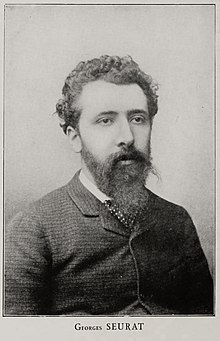Georges-Pierre Seurat
| Georges Seurat | |
|---|---|

Georges Seurat, 1888
|
|
| Born |
Georges-Pierre Seurat 2 December 1859 Paris, France |
| Died | 29 March 1891 (aged 31) Paris, France |
| Nationality | French |
| Known for | Painting |
| Notable work | A Sunday Afternoon on the Island of La Grande Jatte |
| Movement | Post-Impressionism, neo-impressionism, Pointillism |
Georges-Pierre Seurat (French: [ʒɔʁʒ pjɛʁ sœʁa]; 2 December 1859 – 29 March 1891) was a French post-Impressionist painter and draftsman. He is noted for his innovative use of drawing media and for devising the painting techniques known as chromoluminarism and pointillism. Seurat's artistic personality was compounded of qualities which are usually supposed to be opposed and incompatible: on the one hand, his extreme and delicate sensibility; on the other, a passion for logical abstraction and an almost mathematical precision of mind. His large-scale work, A Sunday Afternoon on the Island of La Grande Jatte (1884–1886), altered the direction of modern art by initiating Neo-impressionism, and is one of the icons of late 19th-century painting.
Seurat was born 2 December 1859 in Paris, at 60 rue de Bondy (now rue René Boulanger). The Seurat family moved to 136 boulevard de Magenta (now 110 boulevard de Magenta) in 1862 or 1863. His father, Antoine Chrysostome Seurat, originally from Champagne, was a former legal official who had become wealthy from speculating in property, and his mother, Ernestine Faivre, was from Paris. Georges had a brother, Émile Augustin, and a sister, Marie-Berthe, both older. His father lived in Le Raincy and visited his wife and children once a week at boulevard de Magenta.
Georges Seurat first studied art at the École Municipale de Sculpture et Dessin, near his family's home in the boulevard Magenta, which was run by the sculptor Justin Lequien. In 1878 he moved on to the École des Beaux-Arts where he was taught by Henri Lehmann, and followed a conventional academic training, drawing from casts of antique sculpture and copying drawings by old masters. Seurat's studies resulted in a well-considered and fertile theory of contrasts: a theory to which all his work was thereafter subjected. His formal artistic education came to an end in November 1879, when he left the École des Beaux-Arts for a year of military service.
...
Wikipedia
